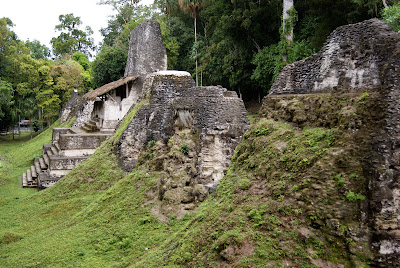After the manicured lawns, stay-on-the-path attitude, and
intrusive presence of handicraft vendors at the ruins of Palenque, not to
mention the influx of dreaded, beaded new age hippies from the nearby Rainbow
Gathering, Toniná’s ruins were a surprising, but welcome, change.
A hoof-beaten path carried us to the ruins, a high Mexican
sun beating down on our shoulders. Perched high atop a hill overlooking ranches
and farms, Toniná boasts neither the jungle setting nor the vast throngs of
tourists of many neighboring Mayan sites. Had it not been a Sunday, I suspect we would have had the place to ourselves, as the only other tourists present were Mexican.
Stacked, tier by tier, terrace on top of terrace, the ruins climb up rather than spreading out into multiple buildings and clusters. So upward we went, sometimes on steps jagged, narrow, and uneven. Higher and higher, steep and slow.
Between the ruins and its museum, a large number of
surprisingly intact sculptures and friezes were on display, a great many
showing the war-hungry inhabitants decapitating their enemies. It is amazing to
see the detail that can remain after so many centuries, stories told in stone,
cut and chiseled remnants of an entire culture.
















































